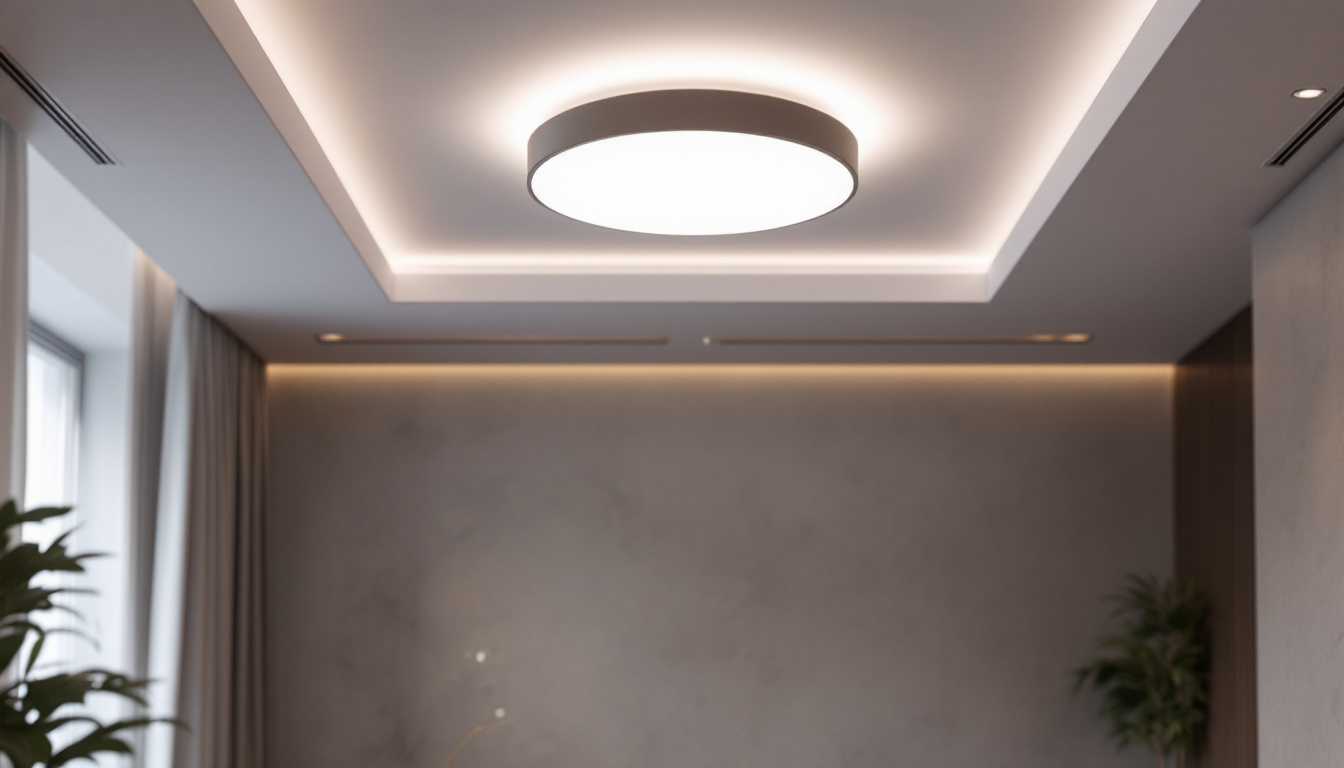
In the ever-evolving world of lighting design, flush LED ceiling lights have emerged as a popular choice for both residential and commercial spaces. Their sleek design, energy efficiency, and versatility make them a staple in modern lighting solutions. For lighting contractors, understanding the nuances of flush LED ceiling lights is essential for delivering quality installations and meeting client expectations. This article delves into the critical aspects of flush LED ceiling lights that every lighting contractor should be well-versed in.
Flush LED ceiling lights are fixtures that are mounted directly against the ceiling, providing a clean and unobtrusive look. Unlike pendant or semi-flush fixtures, they do not hang down, making them ideal for spaces with low ceilings or where a minimalist aesthetic is desired. These lights come in various shapes, sizes, and designs, catering to different tastes and functional needs. With the advancement of technology, many flush LED lights now also offer smart features, allowing users to control brightness and color temperature through mobile apps or voice-activated devices, further enhancing their appeal.
One of the standout features of flush LED ceiling lights is their energy efficiency. Compared to traditional incandescent bulbs, LEDs consume significantly less energy, which translates to lower utility bills for clients. Additionally, they have a longer lifespan, reducing the frequency of replacements and maintenance. This longevity not only contributes to cost savings but also minimizes waste, making them an environmentally friendly choice for eco-conscious consumers.
Another benefit is the versatility in design. Flush LED ceiling lights can complement various interior styles, from modern to traditional. They can be found in an array of finishes, including brushed nickel, matte black, and polished chrome, allowing contractors to match fixtures to their clients’ décor seamlessly. Furthermore, many designs incorporate decorative elements such as glass shades or intricate patterns, which can add a touch of elegance and personality to any room.
Flush LED ceiling lights are suitable for a wide range of applications. In residential settings, they are commonly used in kitchens, hallways, and bedrooms, providing ample illumination without overwhelming the space. In commercial environments, these fixtures are ideal for offices, retail spaces, and lobbies, where a clean and professional look is essential. Their ability to provide uniform lighting helps to create a welcoming atmosphere, which is particularly important in customer-facing areas.
Moreover, their low-profile design makes them an excellent choice for spaces with low ceilings, ensuring that they do not obstruct sightlines or create a cramped feeling. This adaptability is a key selling point for contractors when discussing options with clients. Additionally, flush LED ceiling lights can be strategically placed to highlight architectural features or artwork, enhancing the overall aesthetic of a room. In open-concept spaces, they can be used to delineate areas without the need for physical barriers, maintaining an airy and spacious feel while ensuring adequate lighting throughout.
When selecting flush LED ceiling lights, several features should be considered to ensure optimal performance and client satisfaction. These include brightness, color temperature, dimming capabilities, and installation requirements.
Brightness is a critical factor in any lighting installation. The brightness of LED fixtures is measured in lumens, and understanding the appropriate lumen output for different spaces is essential. For instance, a kitchen may require around 300-400 lumens per square meter, while a bedroom may need less, around 150-250 lumens.
Contractors should also consider the fixture’s distribution of light. Some flush LED ceiling lights offer a wide beam angle, providing even illumination across a room, while others may focus light more narrowly, creating pools of light that can enhance specific areas. This is particularly useful in spaces where tasks are performed, such as reading nooks or workstations, where targeted lighting can significantly improve functionality and comfort.
Color temperature, measured in Kelvin (K), plays a significant role in the ambiance of a space. Warm white light (2700K-3000K) creates a cozy atmosphere, making it suitable for living rooms and bedrooms. In contrast, cool white light (4000K-5000K) is ideal for task-oriented areas like kitchens and offices, where clarity and focus are essential.
Lighting contractors should be prepared to educate clients on the impact of color temperature on mood and functionality, helping them choose the right options for their specific needs. Additionally, there are also daylight options (5000K-6500K) that mimic natural sunlight, which can be beneficial in spaces where people spend extended periods, as it can help reduce eye strain and improve overall well-being.
Dimming capabilities can enhance the versatility of flush LED ceiling lights. Many modern fixtures come with integrated dimming options or are compatible with external dimmers. This feature allows users to adjust the brightness according to their preferences or the time of day, contributing to energy savings and extending the lifespan of the fixtures.
When discussing dimming options with clients, it is crucial to ensure compatibility with existing systems, as not all LED fixtures work with every dimmer. Providing guidance on this aspect can prevent future issues and enhance customer satisfaction. Furthermore, some advanced dimming systems allow for smart home integration, enabling users to control their lighting through mobile apps or voice commands, adding a layer of convenience and modernity to their living spaces.
Proper installation is vital for the performance and longevity of flush LED ceiling lights. Lighting contractors should be familiar with the specific installation requirements of different fixtures, as these can vary significantly.
Before installation, it is essential to assess the electrical requirements of the chosen fixtures. Most flush LED ceiling lights operate on standard voltage, but some may require specific wiring or transformers. Contractors should verify the compatibility with existing electrical systems to avoid complications during installation.
Additionally, understanding local electrical codes and regulations is crucial to ensure compliance and safety. This knowledge not only protects the contractor but also instills confidence in clients regarding the quality of the installation.
Flush LED ceiling lights typically come with mounting hardware and instructions. However, contractors should be prepared to adapt these techniques based on the specific ceiling type and conditions. For instance, installing fixtures on drywall may require different anchors than those needed for concrete or plaster ceilings.
Attention to detail during installation can prevent issues such as sagging or misalignment, which can detract from the overall appearance of the lighting. Ensuring a secure and level installation is essential for both aesthetics and functionality.
While LED fixtures are known for their longevity, occasional maintenance and troubleshooting may be necessary. Understanding common issues and their solutions can help contractors provide better service to their clients.
Regular cleaning is essential to maintain the appearance and performance of flush LED ceiling lights. Dust and grime can accumulate on the surface, reducing light output and affecting the overall aesthetic. Contractors should recommend that clients clean their fixtures periodically using a soft, dry cloth to avoid damage.
In addition to cleaning, it is essential to check for any signs of wear or damage, such as flickering lights or unusual noises. Addressing these issues promptly can prevent more significant problems down the line.
If a flush LED ceiling light fails to operate correctly, several troubleshooting steps can be taken. First, check the power supply to ensure that the fixture is receiving electricity. If the power supply is intact, inspect the connections for any loose wires or corrosion.
If the fixture still does not work, it may be necessary to replace the driver or the LED module, depending on the design of the fixture. Familiarity with the specific components of the fixtures being installed can help contractors address these issues efficiently.
As technology and design trends evolve, so do the options available in flush LED ceiling lighting. Staying informed about the latest trends can help lighting contractors offer innovative solutions to their clients.
The rise of smart home technology has influenced the lighting industry significantly. Many flush LED ceiling lights now come with smart capabilities, allowing users to control their lighting via smartphone apps or voice commands. This integration adds convenience and flexibility, appealing to tech-savvy clients.
Contractors should familiarize themselves with the various smart lighting systems available, as well as their compatibility with flush LED fixtures. This knowledge can enhance service offerings and set contractors apart in a competitive market.
With growing awareness of environmental issues, many clients are seeking sustainable lighting solutions. Flush LED ceiling lights are inherently energy-efficient, but contractors can further enhance their sustainability by recommending fixtures made from eco-friendly materials or those that incorporate recyclable components.
Additionally, educating clients about the benefits of energy-efficient lighting can help them make informed decisions that align with their values and contribute to a greener planet.
Flush LED ceiling lights represent a versatile and efficient lighting solution for various applications. For lighting contractors, understanding the key features, installation considerations, and maintenance practices associated with these fixtures is crucial for delivering high-quality service and meeting client expectations.
By staying informed about trends and advancements in the industry, contractors can position themselves as knowledgeable professionals who can guide clients toward the best lighting solutions for their needs. Whether it’s through energy efficiency, design versatility, or smart technology integration, flush LED ceiling lights offer a wealth of opportunities for both contractors and clients alike.
Ready to elevate your lighting installations with the sleek appeal of flush LED ceiling lights? At LumenWholesale, we provide lighting contractors like you with the highest quality, spec-grade lighting products at prices that can’t be beaten. Say goodbye to local distributor markups and hello to our extensive selection that meets rigorous industry standards. With free shipping on bulk orders, you can stock up on premium lighting solutions without worrying about hidden fees. Don’t compromise on quality or value—choose LumenWholesale for the perfect fusion of affordability and convenience. Explore our wholesale lighting options now and secure the best value for your next project.

Discover how T8 fluorescent bulbs can transform your lighting projects and give you a competitive edge in securing more contracts.

Discover how a groundbreaking invention revolutionized safety standards in lighting, surpassing traditional oil lamps.

Discover essential tips and expert advice for lighting contractors on selecting the perfect pendant lights.

Discover the essential guide for lighting contractors with “Illuminating Light Switch: The Ultimate Lighting Contractor Checklist.” This comprehensive article provides expert insights, practical tips, and a step-by-step checklist to ensure flawless lighting installations and client satisfaction.